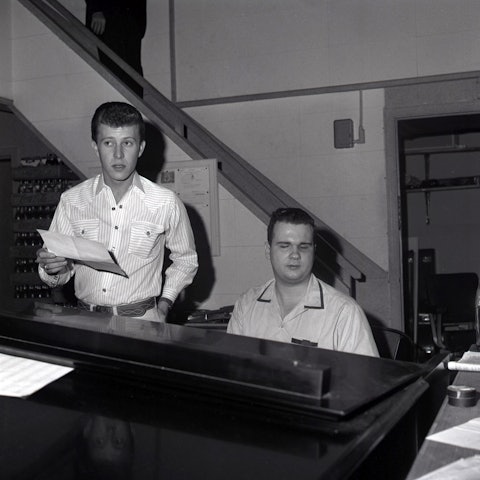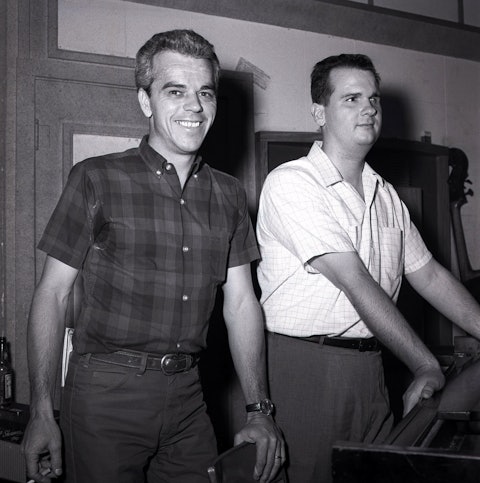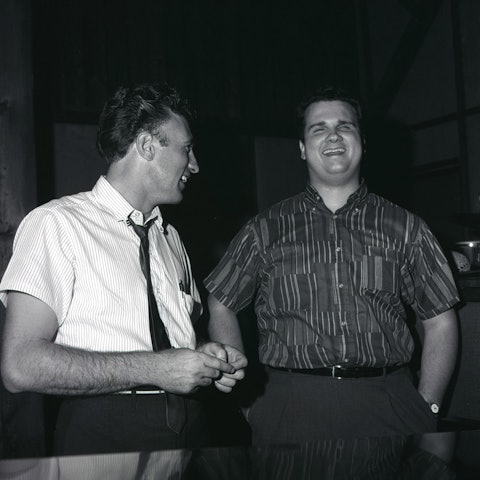Hargus "Pig"
Robbins

-
Inducted2012
-
Born
January 18, 1938
-
Died
January 30, 2022
-
Birthplace
Rhea County, Tennessee
Working thousands of recording dates since the late 1950s, Hargus “Pig” Robbins has contributed to dozens of hits by artists in country, rock, folk, and pop. “Of all the musicians on my sessions,” said veteran producer Jerry Kennedy, “he stood tallest. He has been a backbone for Nashville.”
How Hargus Robbins Became “Pig”
Robbins was born Hargus Melvin Robbins in Rhea County, Tennessee, on January 18, 1938. A knife accident at age three robbed him of his sight, and he went on to study classical piano at the Tennessee School for the Blind, beginning at age seven. At the same time, however, he began to develop his own style by listening to pop and jazz pianists including Owen Bradley, Ray Charles, Floyd Cramer, Poppa John Gordy, and Marvin Hughes on the radio and on records.
“I got [the nickname] ‘Pig’ at school.” Robbins explained. “I had a supervisor who called me that because I used to sneak in through a fire escape and play when I wasn’t supposed to, and I’d get dirty as a pig.”
Robbins eventually played in Nashville clubs, and he gained entrée into studio recording in 1959 with his lively playing on George Jones’s #1 hit “White Lightning.” From that point, Robbins’s session calls increased, especially after studio pianist Floyd Cramer began spending much of his time as a successful touring artist. Robbins fit naturally into Nashville’s A-Team, an elite group of top studio players who long dominated the city’s recording scene.
Songs
00:00 / 00:00
00:00 / 00:00
00:00 / 00:00
In-Demand Nashville Pianist
Over the next several decades, Robbins often worked hundreds of sessions each year, lending his distinctive touch and impeccable musical taste to hits by Patsy Cline, Loretta Lynn, Connie Smith, the Statler Brothers, and dozens of other country stars. The pianist’s intros to Charlie Rich’s “Behind Closed Doors” (1973) and Crystal Gayle’s “Don’t It Make My Brown Eyes Blue” (1977) are only two examples of his many memorable stylings.
“Pig has come up with more identifiable licks than anyone,” studio guitarist and Country Music Hall of Fame member Harold Bradley said. “And he’s also the best rhythm piano player in town.”
“He’s part of the reason I’m here,” said Connie Smith, also elected to the Hall of Fame in 2012. “He just has a feel for what’s needed, and he never misses.”
As session keyboardist Ron Oates observed, “Pig can go straight to the heart of a song and grab something that was waiting only for him to add to the arrangement. Whatever he plays is so ‘natural,’ so ‘right’—but no one else would have ever thought of it.”
Jerry Kennedy put it this way: “Pig made me feel that I had the very best out there in the studio. Having Pig tying a bow around a session was always a great feeling.”
Image Gallery
-

Hargus "Pig" Robbins (right) and singer Darrell McCall during a 1960s session at Columbia Records Studio B.
-

Hargus “Pig” Robbins (right) and singer Roy Drusky during a 1960s session at Columbia Records Studio B.
-

Hargus "Pig" Robbins (right) and singer Hugh X. Lewis during a 1960s session at Columbia Records Studio B.
A Versatile Player with a Keen Sense of Humor
“He’s just a super talent,” guitarist Ray Edenton stressed. “He has the greatest memory of any musician I know. He couldn’t write chords down, of course, but on most sessions he only needed to hear a song once, and he’d have it. On show tunes that might have three key changes, four tempo changes, and lots of chord changes, some of us would have to stop and ask him, ‘What goes here?’ And he’d tell us.”
Edenton also recalled Robbins’s patience and sense of humor: “He was such a good guy that he didn’t get mad at anything we pulled on him, like turning his ash tray around so he’d reach for his cigarette and think it was missing. He’d just light another one. But he got us back, too. One time a bunch of us were in a studio hallway when the lights suddenly went out. We started hollering, and Pig said, ‘All right. Let’s see you find your way out of here now!’ Finally, he led us to the door, because he knew exactly where he was—just how many steps he had to take to the stairway, and how many stairs there were.”
Robbins’s contributions to Bob Dylan’s album Blonde on Blonde (1966) made him popular with folk, rock, and pop singers including British pop vocalist Cliff Richard and the versatile Leon Russell, among many others. Though his once-hectic recording schedule has slowed, Robbins remains an influential and active session musician, working with artists such as Alan Jackson, Miranda Lambert, Sturgill Simpson, and Marty Stuart.
While supporting others in the studio, Robbins recorded as a featured instrumental artist, making albums for the Chart and Time labels in the 1960s. During the late 1970s, Elektra Records released three of his albums: the Grammy-winning Country Instrumentalist of the Year (1977), Pig in a Poke (1978), and Unbreakable Hearts (1979). The pianist was the Country Music Association’s Instrumentalist of the Year in 1976 and 2000.
Multi-instrumentalist Charlie McCoy, who was elected to the Country Music Hall of Fame in 2009, agreed wholeheartedly: “He’s the best session player I’ve ever worked with. When he’s on a session, everybody else plays better.”
—Bob Millard
Adapted from the Country Music Hall of Fame® and Museum’s Encyclopedia of Country Music, published by Oxford University Press
“He’s the best session player I’ve ever worked with. When he’s on a session, everybody else plays better.” — Charlie McCoy



